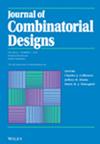Bent Functions on Finite Nonabelian Groups and Relative Difference Sets
IF 0.8
4区 数学
Q3 MATHEMATICS
引用次数: 0
Abstract
It is well known that the perfect nonlinearity of a function between finite groups and can be characterized by its graph in terms of relative difference set in the direct product (cf. [4]). Let be the infinite set of complex roots of unity. A -valued function on an arbitrary finite group is associated with a finite cyclic subgroup in the multiplicative group of nonzero complex numbers. For a bent function on in general, its graph is not a relative difference set in the direct product . In this paper, we investigate the necessary and sufficient conditions under which the graph of a bent function on is a relative difference set in . Cyclotomic fields and their integral bases play an important role in our discussions.
有限非贝尔群和相对差分集上的弯曲函数
众所周知,有限群G和有限群H之间的函数的完全非线性可以用它的图用直接积G的相对差集来表示× H (cf.[4])。设T是无穷个单位复数根的集合。任意有限群G上的一个T值函数f与一个有限循环子群相关联T f在非零复数的乘法群中。对于f在G上的弯曲函数,它的图不是直接积G × T f的相对差集。在本文中,研究了G上的弯曲函数f的图是G ×上的相对差集的充分必要条件T。旋光场及其整体基础在我们的讨论中起着重要作用。
本文章由计算机程序翻译,如有差异,请以英文原文为准。
求助全文
约1分钟内获得全文
求助全文
来源期刊
CiteScore
1.60
自引率
14.30%
发文量
55
审稿时长
>12 weeks
期刊介绍:
The Journal of Combinatorial Designs is an international journal devoted to the timely publication of the most influential papers in the area of combinatorial design theory. All topics in design theory, and in which design theory has important applications, are covered, including:
block designs, t-designs, pairwise balanced designs and group divisible designs
Latin squares, quasigroups, and related algebras
computational methods in design theory
construction methods
applications in computer science, experimental design theory, and coding theory
graph decompositions, factorizations, and design-theoretic techniques in graph theory and extremal combinatorics
finite geometry and its relation with design theory.
algebraic aspects of design theory.
Researchers and scientists can depend on the Journal of Combinatorial Designs for the most recent developments in this rapidly growing field, and to provide a forum for both theoretical research and applications. All papers appearing in the Journal of Combinatorial Designs are carefully peer refereed.

 求助内容:
求助内容: 应助结果提醒方式:
应助结果提醒方式:


